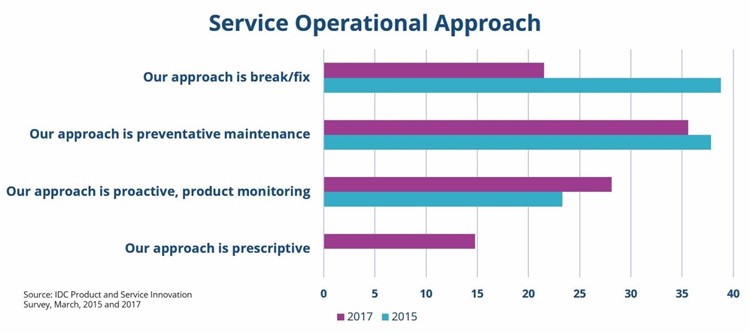Connected Product Growth Fuels The Progression Toward Prescriptive Service

By Heather Ashton, IDC Manufacturing Insights
The rise of IoT, connected products, and cognitive computing have all thrust the service organization into the spotlight as a source for new revenue opportunities and greater engagement with customers to drive loyalty, satisfaction, and repeat business. With the rise of connected products, the opportunities for delivering additional services and customer value to the installed base has increased significantly. At IDC, we have been tracking this evolution for some time, and the results are most evident in our surveys regarding connected products and connected services. Increasingly, original equipment manufacturers seek to use Internet of Things (IoT) and technologies like cloud, mobile, and big data analytics, to increase visibility of the installed assets out in the field, and move the pendulum for service from reactive toward predictive, and eventually prescriptive, service. As a result, field service management is a critical delivery channel for leveraging this new connectivity.
Where are manufacturers in this process of connecting their installed base through IoT? Making progress, based on our most recent 2017 IDC Product and Service Innovation Survey, a survey of 300 manufacturing respondents in the United States and Canada that assessed business drivers, application areas, and technology investment trends for both the product and service lifecycles in manufacturing companies across value chains. This year, 18 percent of respondents reported that more than a quarter of the products they currently manufacture are considered connected. We define "connected" as having a unique IP address and software within the product to enable service and product performance information to be communicated over a wireless network. Looking ahead, three years from now, 28 percent of these manufacturers expect that more than a quarter of their manufactured products will be connected.
What does this mean from a service management perspective? For service organizations, the IoT connectivity changes the landscape of service delivery in some fundamental ways, the key one being the move from reactive response to service events toward more proactive responses. We've been tracking this trend at IDC as well, as it correlates to the level of connected products in the installed based. Below, you can see the trend in our survey data showing the progression toward predictive and prescriptive service for service organizations.

Note that in 2015, none of the manufacturers surveyed were providing prescriptive service management to their installed base of customers. This is because prescriptive service requires adoption of a number of complex technologies and business processes. Our definition of prescriptive service encompasses products that have autonomic capabilities to report problems/issues and request repair or service. Prescriptive service requires IoT, big data analytics, cloud, and artificial intelligence along with integration of all process and systems that support the service lifecycle, including product monitoring, field service ticketing/scheduling, spare parts inventory, workforce management, installed base management, and warranty and contract systems.
As manufacturers move down the path of increasing the connectivity of their installed base of products and evolving their service approach from reactive to proactive and prescriptive, field service organizations will continue to be vital to delivering exceptional customer experiences. It will be important for service organizations to work with product management to increase their installed base connectivity to support this move toward value-added services, and instrumenting their field service technicians with the visibility into that installed base.
For more information, visit IDC.com and our IDC Community, a free resource where participants can engage with IDC industry analysts, share knowledge and best practices, and connect with colleagues.
